Investigation of the Electrochemical Performance of Titanium-Based MXene Hybridisation with Rice Husk Ash (RHA) as an Anode Catalyst Support Material
Abstract
:1. Introduction
2. Materials and Methods
2.1. Hybrid RHA/MXene Preparation
2.2. Electrode Preparation
2.3. Electrochemical Measurement
3. Results
3.1. Hybrid Composites Structural Characterisation
3.2. Electrochemical Performance Analysis
4. Conclusions
- Cheap and environmentally friendly source of material;
- High electrochemical performance in electrocatalytic activity;
- High retention rate and low oxidation poisoning rate;
- Minimal corrosion reaction and tolerance in a methanol medium.
Author Contributions
Funding
Data Availability Statement
Acknowledgments
Conflicts of Interest
References
- Ramli, Z.A.C.; Shaari, N.; Saharuddin, T.S.T. Progress and major BARRIERS of nanocatalyst development in direct methanol fuel cell: A review. Int. J. Hydrogen Energy 2022, 47, 22114–22146. [Google Scholar] [CrossRef]
- Zuo, Y.; Sheng, W.; Tao, W.; Li, Z. Direct methanol fuel cells system–A review of dual-role electrocatalysts for oxygen reduction and methanol oxidation. J. Mater. Sci. Technol. 2022, 114, 29–41. [Google Scholar] [CrossRef]
- de Sá, M.H.; Pinto, A.M.F.R.; Oliveira, V.B. Passive direct methanol fuel cells as a sustainable alternative to batteries in hearing aid devices—An overview. Int. J. Hydrogen Energy 2022, 47, 16552–16567. [Google Scholar] [CrossRef]
- Sarfraz, A.; Ali, A.; Ahmad, B.; Mushtaq, M.N.; Ahmad, M.A.; Raza, A.H.; Akbar, M.; Raza, R.; Syväjärvi, M. Catalytic Effect of Silicon Carbide on the Composite Anode of Fuel Cells. ACS Appl. Energy Mater. 2021, 4, 6436–6444. [Google Scholar] [CrossRef]
- Baronia, R.; Goel, J.; Tiwari, S.; Singh, P.; Singh, D.; Singh, S.P.; Singhal, S.K. Efficient electro-oxidation of methanol using PtCo nanocatalysts supported reduced graphene oxide matrix as anode for DMFC. Int. J. Hydrogen Energy 2017, 42, 10238–10247. [Google Scholar] [CrossRef]
- Zhao, G.; Zhao, T.S.; Xu, J.; Lin, Z.; Yan, X. Impact of pore size of ordered mesoporous carbon FDU-15-supported platinum catalysts on oxygen reduction reaction. Int. J. Hydrogen Energy 2017, 42, 3325–3334. [Google Scholar] [CrossRef]
- Daniel-Mkpume, C.C.; Aigbodion, V.S.; Obikwelu, D.O.N. Electrochemical analysis and microstructure of value-added functional Zn-ZnO-rice husk ash composite coating of mild steel. Chem. Data Collect. 2021, 35, 100767. [Google Scholar] [CrossRef]
- Temeche, E.; Zhang, X.; Laine, R.M. Electrochemical Performance of LixSiON Polymer Electrolytes Derived from an Agriculture Waste Product, Rice Hull Ash. ACS Appl. Polym. Mater. 2021, 3, 2144–2152. [Google Scholar] [CrossRef]
- Lee, S.J.; Lee, D.H.; Lee, W.-Y. An electrochemical sensor for capsaicin based on two-dimensional titanium carbide (MXene)-doped titania-Nafion composite film. Microchem. J. 2023, 185, 108216. [Google Scholar] [CrossRef]
- Bhat, A.; Anwer, S.; Bhat, K.S.; Mohideen, M.I.H.; Liao, K.; Qurashi, A. Prospects challenges and stability of 2D MXenes for clean energy conversion and storage applications. NPJ 2D Mater. Appl. 2021, 5, 61. [Google Scholar] [CrossRef]
- Thakur, N.; Kumar, P.; Sati, D.C.; Neffati, R.; Sharma, P. Recent advances in two-dimensional MXenes for power and smart energy systems. J. Energy Storage 2022, 50, 104604. [Google Scholar] [CrossRef]
- Mozafari, M.; Soroush, M. Surface functionalization of MXenes. Mater. Adv. 2021, 2, 7277–7307. [Google Scholar] [CrossRef]
- Hu, M.; Hu, T.; Cheng, R.; Yang, J.; Cui, C.; Zhang, C.; Wang, X. MXene-coated silk-derived carbon cloth toward flexible electrode for supercapacitor application. J. Energy Chem. 2018, 27, 161–166. [Google Scholar] [CrossRef]
- Ye, F.; Wang, Z.; Xu, C.; Yuan, M.; Liu, P.; Yang, W.; Liu, G. Mechanism and kinetic study of pulse electrodeposition process of Pt/C catalysts for fuel cells. Renew. Energy 2020, 145, 514–520. [Google Scholar] [CrossRef]
- Simari, C.; Stallworth, P.; Peng, J.; Coppola, L.; Greenbaum, S.; Nicotera, I. Graphene oxide and sulfonated-derivative: Proton transport properties and electrochemical behavior of Nafion-based nanocomposites. Electrochim. Acta 2019, 297, 240–249. [Google Scholar] [CrossRef]
- Berghian-Grosan, C.; Radu, T.; Biris, A.R.; Dan, M.; Voica, C.; Watanabe, F.; Biris, A.S.; Vulcu, A. Platinum nanoparticles coated by graphene layers: A low-metal loading catalyst for methanol oxidation in alkaline media. J. Energy Chem. 2020, 40, 81–88. [Google Scholar] [CrossRef]
- Li, X.; Lv, Y.; Pan, D. Pt catalysts supported on lignin-based carbon dots for methanol electro-oxidation. Colloids Surf. A Physicochem. Eng. Asp. 2019, 569, 110–118. [Google Scholar] [CrossRef]
- Karaoglan, M.U.; Ince, A.C.; Glüsen, A.; Colpan, C.O.; Müller, M.; Stolten, D.; Kuralay, N.S. Comparison of single-cell testing, short-stack testing and mathematical modeling methods for a direct methanol fuel cell. Int. J. Hydrogen Energy 2021, 46, 4844–4856. [Google Scholar] [CrossRef]
- Mathew, A.S.; Naigil, B.; George, E.; Benny, E.; Baby, R. Design, fabrication and testing of a direct methanol fuel cell stack. Mater. Today Proc. 2022, 58, 400–406. [Google Scholar] [CrossRef]
- Munjewar, S.S.; Thombre, S.B.; Mallick, R.K. Approaches to overcome the barrier issues of passive direct methanol fuel cell—Review. Renew. Sus. Energy Rev. 2017, 67, 1087–1104. [Google Scholar] [CrossRef]
- Shuck, C.E.; Gogotsi, Y. Taking MXenes from the lab to commercial products. J. Chem. Eng. 2020, 401, 125786. [Google Scholar] [CrossRef]
- Lim, G.P.; Soon, C.F.; Morsin, M.; Ahmad, M.K.; Nayan, N.; Tee, K.S. Synthesis, characterization and antifungal property of Ti3C2Tx MXene nanosheets. Ceram. Int. 2020, 46, 20306–20312. [Google Scholar] [CrossRef]
- Vieira, A.P.; Filho, R.D.T.; Tavares, L.M.; Cordeiro, G.C. Effect of particle size, porous structure and content of rice husk ash on the hydration process and compressive strength evolution of concrete. Constr Build Mater. 2020, 236, 117553. [Google Scholar] [CrossRef]
- Alnoor, H.; Elsukova, A.; Palisaitis, J.; Persson, I.; Tseng, E.N.; Lu, J.; Hultman, L.; Persson, P.O.Å. Exploring MXenes and their MAX phase precursors by electron microscopy. Mater. Today Adv. 2021, 9, 100123. [Google Scholar] [CrossRef]
- Grzegórska, A.; Wysocka, I.; Głuchowski, P.; Ryl, J.; Karczewski, J.; Zielińska-Jurek, A. Novel composite of Zn/Ti-layered double hydroxide coupled with MXene for the efficient photocatalytic degradation of pharmaceuticals. Chemosphere 2022, 308, 136191. [Google Scholar] [CrossRef]
- Das, S.K.; Mishra, J.; Singh, S.K.; Mustakim, S.M.; Patel, A.; Das, S.K.; Behera, U. Characterization and utilization of rice husk ash (RHA) in fly ash—Blast furnace slag based geopolymer concrete for sustainable future. Mater. Today Proc. 2020, 33, 5162–5167. [Google Scholar] [CrossRef]
- Ghosh, A.; Pal, H.; Das, T.; Chatterjee, S.; Das, A. Synthesis and Characterization of MXene from MAX phase. Mater. Today Proc. 2022, 58, 714–716. [Google Scholar] [CrossRef]
- Iqbal, M.A.; Tariq, A.; Zaheer, A.; Gul, S.; Ali, S.I.; Iqbal, M.Z.; Akinwande, D.; Rizwan, S. Ti3 C2-MXene/Bismuth Ferrite Nanohybrids for Efficient Degradation of Organic Dyes and Colorless Pollutants. ACS Omega 2019, 4, 20530–20539. [Google Scholar] [CrossRef] [PubMed]
- Montella, C.; Tezyk, V.; Effori, E.; Laurencin, J.; Siebert, E. Linear sweep and cyclic voltammetry of porous mixed conducting oxygen electrode: Formal study of insertion, diffusion and chemical reaction model. Solid State Ion. 2021, 359, 115485. [Google Scholar] [CrossRef]
- Ai, Z.; Chang, B.; Xu, C.; Huang, B.; Wu, Y.; Hao, X.; Shao, Y. Interface engineering in the BNNS@Ti3C2 intercalation structure for enhanced electrocatalytic hydrogen evolution. New J. Chem. 2019, 43, 8613–8619. [Google Scholar] [CrossRef]
- Mansor, M.; Timmiati, S.N.; Wong, W.Y.; Mohd Zainoodin, A.; Lim, K.L.; Kamarudin, S.K. NiPd Supported on Mesostructured Silica Nanoparticle as Efficient Anode Electrocatalyst for Methanol Electrooxidation in Alkaline Media. Catalysts 2020, 10, 1235. [Google Scholar] [CrossRef]
- Huang, L.; Yang, J.; Wu, M.; Shi, Z.; Lin, Z.; Kang, X.; Chen, S. PdAg@Pd core-shell nanotubes: Superior catalytic performance towards electrochemical oxidation of formic acid and methanol. J. Power Sources 2018, 398, 201–208. [Google Scholar] [CrossRef]
- Lee, S.; Jin, X.; Kim, I.Y.; Gu, T.H.; Choi, J.W.; Nahm, S.; Hwang, S.J. Superior additive of exfoliated RuO2 nanosheet for optimizing the electrode performance of metal oxide over graphene. J. Phys. Chem. C 2016, 120, 11786–11796. [Google Scholar] [CrossRef]
- Duarte, T.; Meyer, Y.A.; Osório, W.R. The Holes of Zn Phosphate and Hot Dip Galvanizing on Electrochemical Behaviors of Multi-Coatings on Steel Substrates. Metals 2022, 12, 863. [Google Scholar] [CrossRef]
- Meyer, Y.A.; Menezes, I.; Bonatti, R.S.; Bortolozo, A.D.; Osório, W.R. EIS Investigation of the Corrosion Behavior of Steel Bars Embedded into Modified Concretes with Eggshell Contents. Metals 2022, 12, 417. [Google Scholar] [CrossRef]
- Han, L.; Cui, P.; He, H.; Liu, H.; Peng, Z.; Yang, J. A seed-mediated approach to the morphology-controlled synthesis of bimetallic copper–platinum alloy nanoparticles with enhanced electrocatalytic performance for the methanol oxidation reaction. J. Power Sources 2015, 286, 488–494. [Google Scholar] [CrossRef]
- Mansor, M.; Timmiati, S.N.; Zainoodin, A.M.; Pa’ad, K.M.; Lim, K.L. Investigation of palladium-mesostructured silica nanoparticles (Pd-MSN) as anode electrocatalyst for alkaline direct methanol fuel cell. Chem. Phys. Lett. 2021, 785, 139125. [Google Scholar] [CrossRef]
- Jiang, C.; Zhan, B.; Li, C.; Huang, W.; Dong, X. Synthesis of three-dimensional self-standing graphene/Ni(OH)2 composites for high-performance supercapacitors. RSC Adv. 2014, 4, 18080–18085. [Google Scholar] [CrossRef]
- Ishak, N.A.I.M.; Kamarudin, S.K.; Timmiati, S.N.; Karim, N.A.; Basri, S. Biogenic platinum from agricultural wastes extract for improved methanol oxidation reaction in direct methanol fuel cell. J. Adv. Res. 2021, 28, 63–75. [Google Scholar] [CrossRef] [PubMed]
- Jin, X.; Shin, S.-J.; Kim, N.; Kang, B.; Piao, H.; Choy, J.-H.; Kim, H.; Hwang, S.-J. Superior role of MXene nanosheet as hybridization matrix over graphene in enhancing interfacial electronic coupling and functionalities of metal oxide. Nano Energy 2018, 53, 841–848. [Google Scholar] [CrossRef]
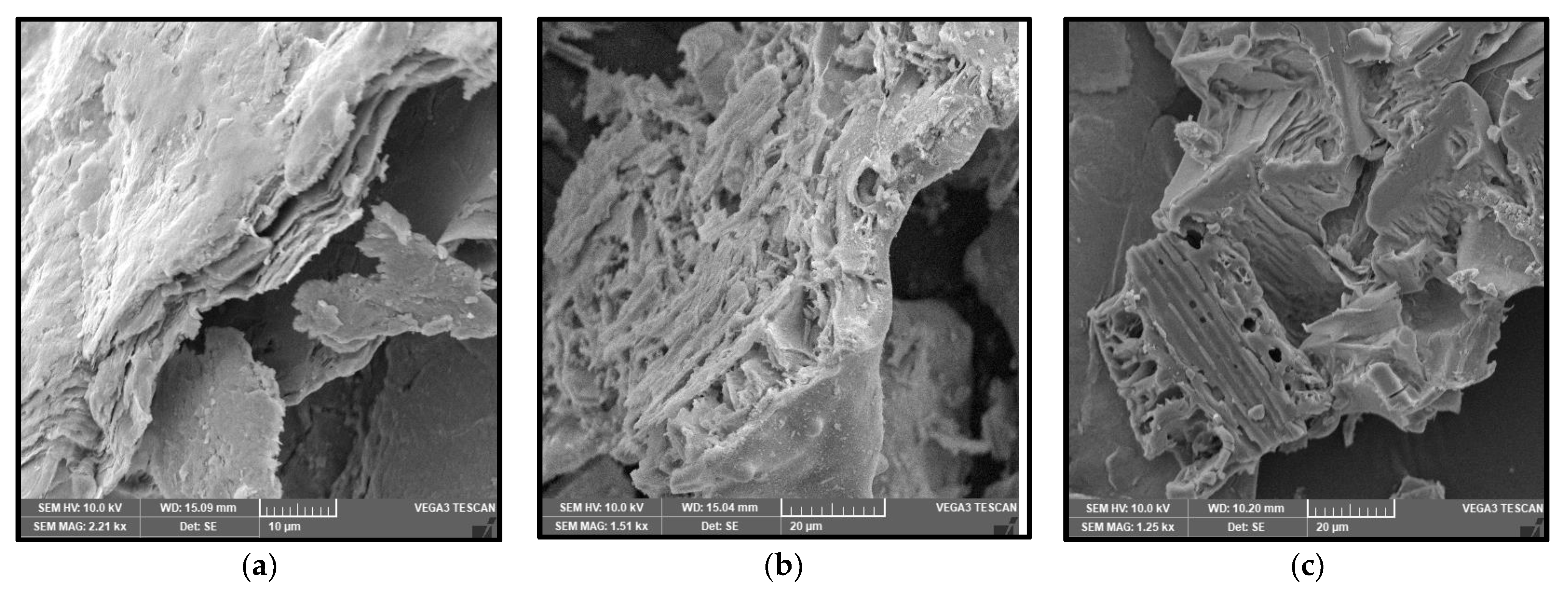


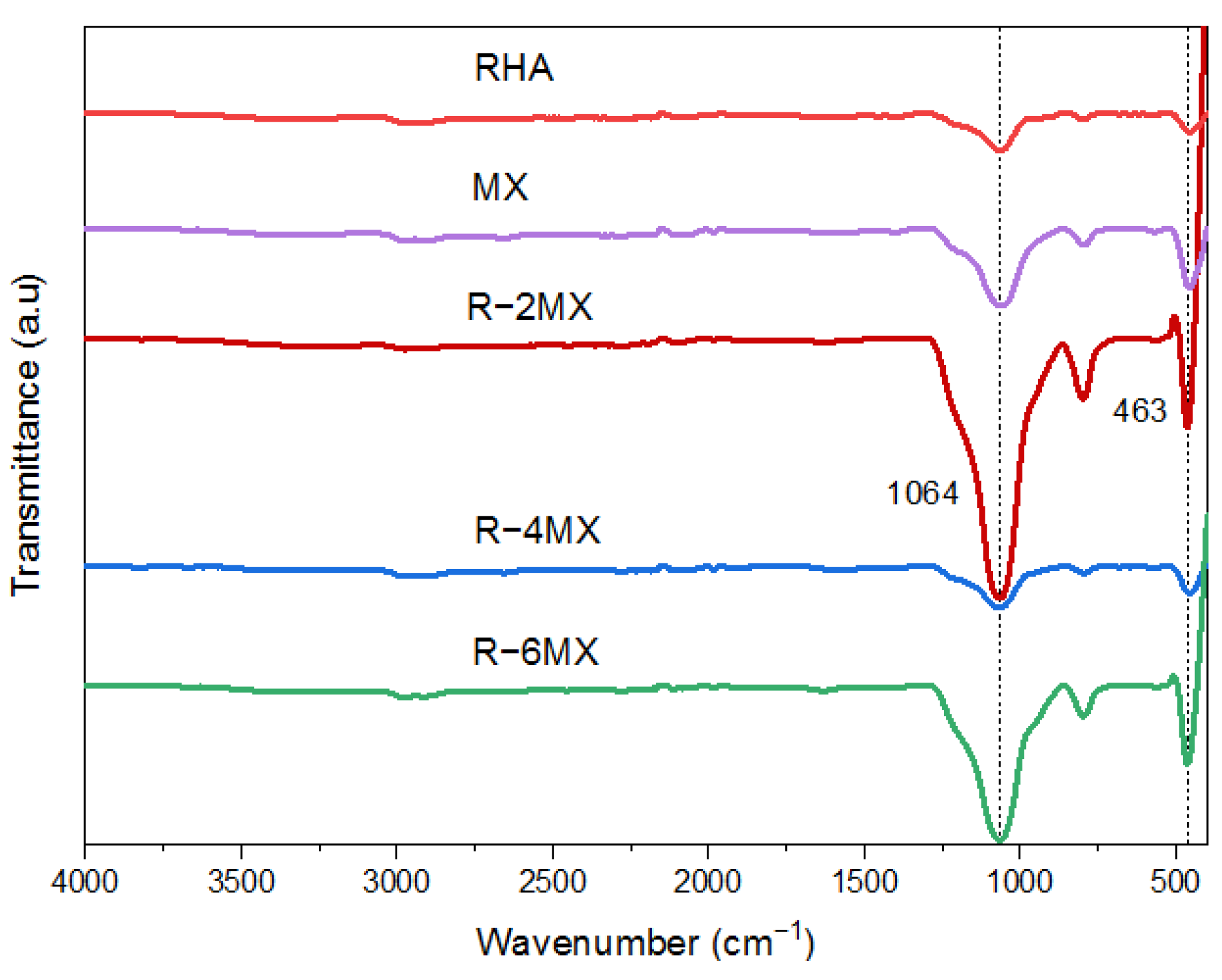

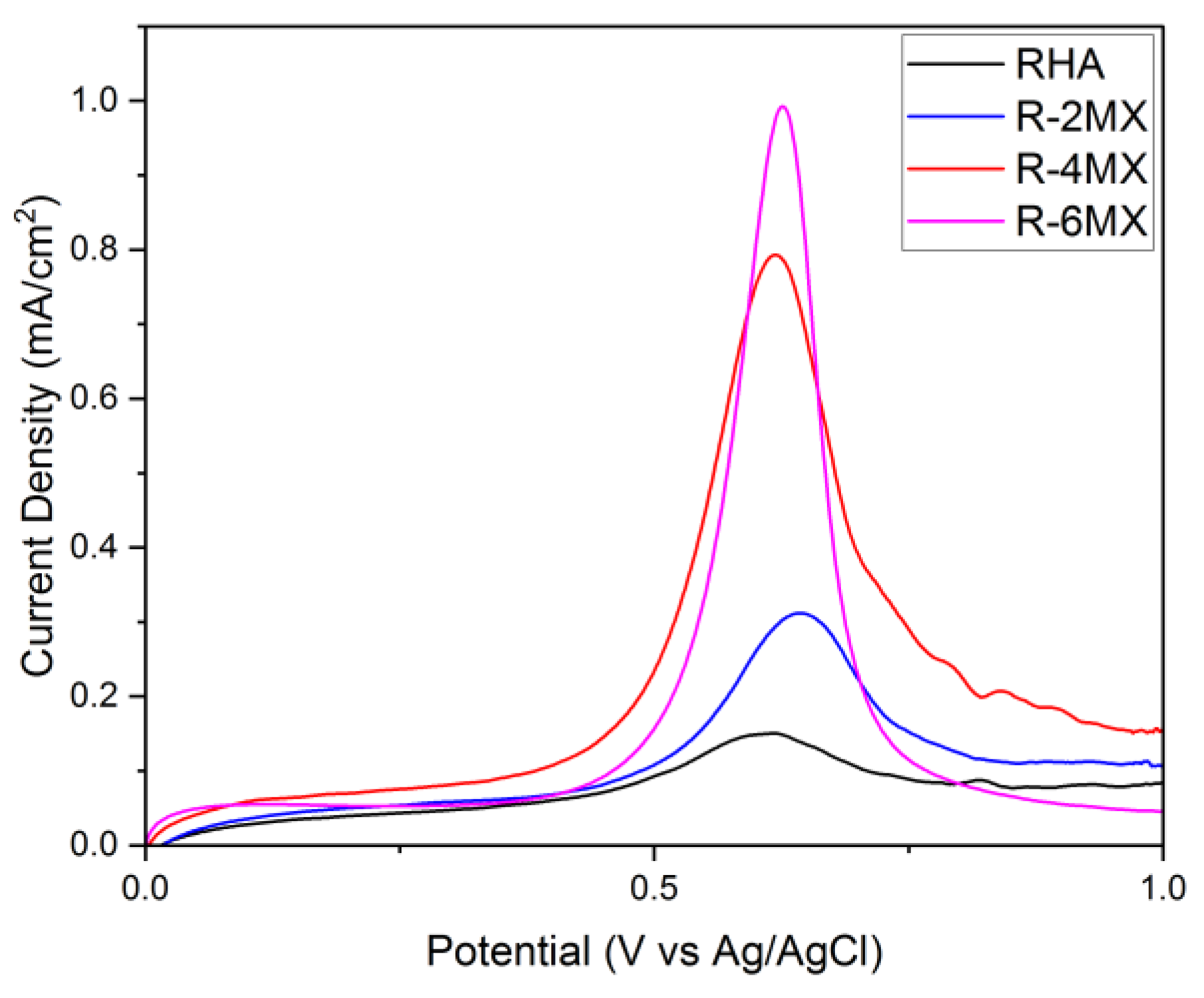
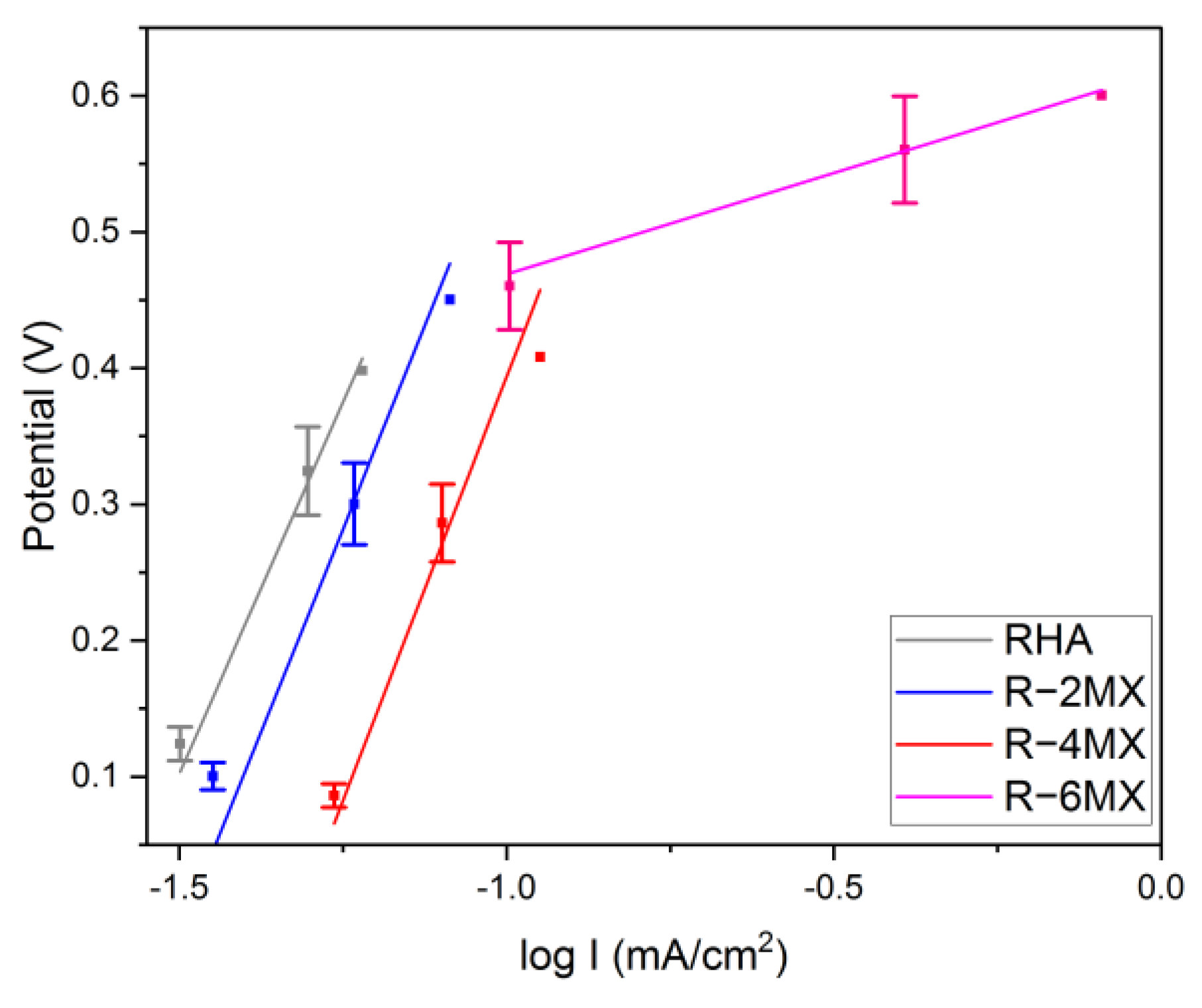
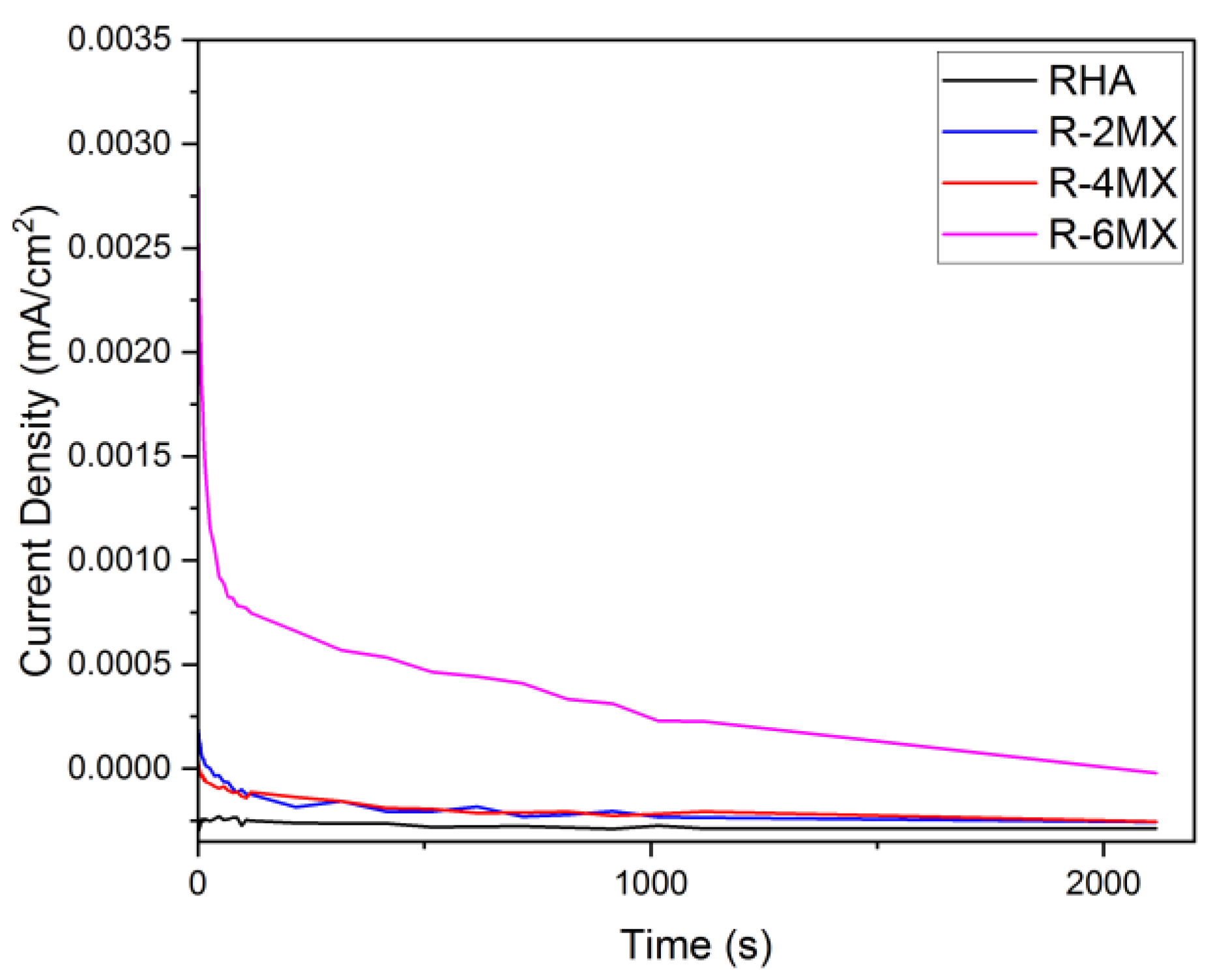
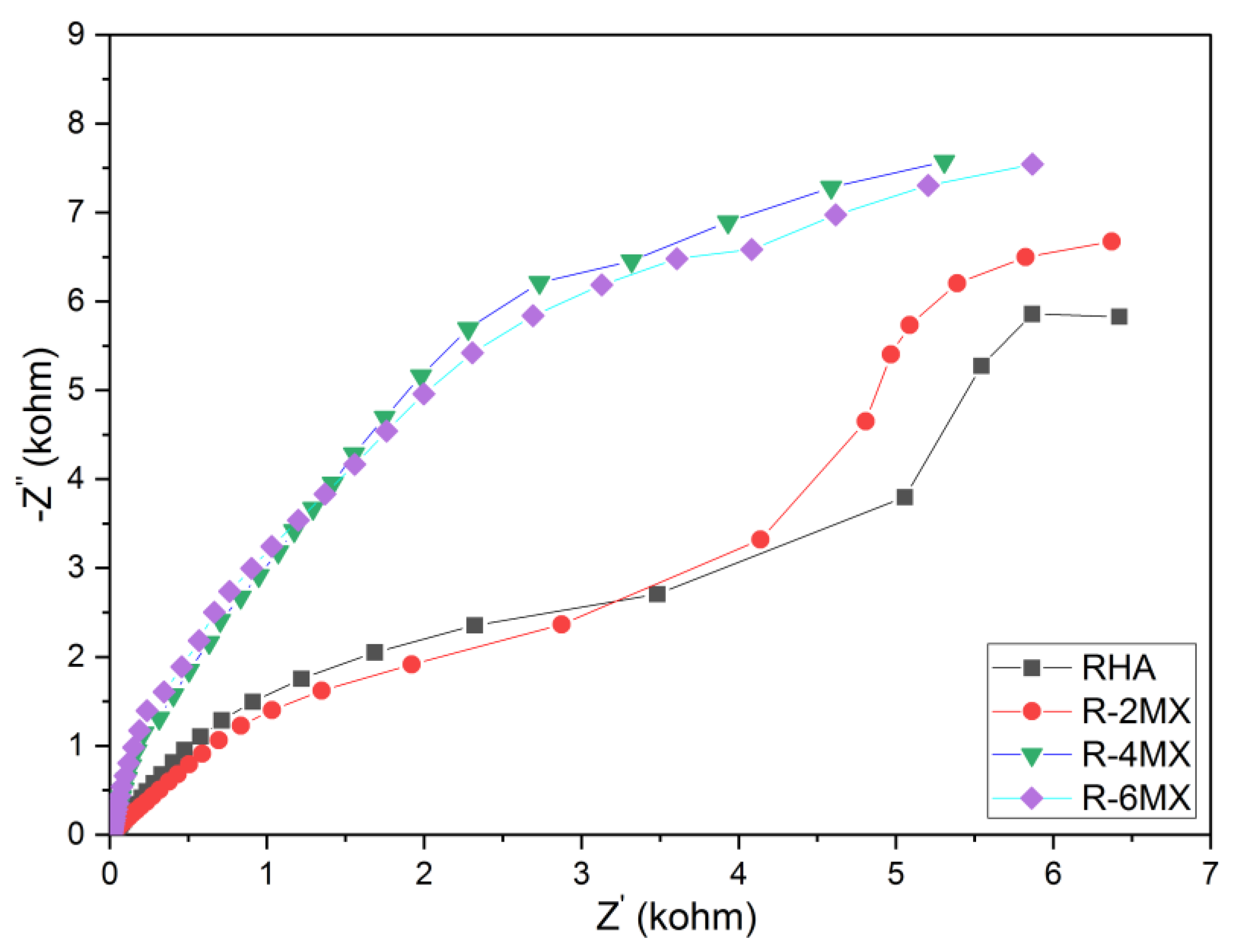
| Electrocatalyst | Tafel Slope, b (mV/dec) | Ion Exchange Current Density, a (mA/cm2) | Standard Deviation, R2 |
|---|---|---|---|
| RHA | 1090 | −1.7376 | 0.9945 |
| R-2MX | 1191 | −1.7717 | 0.9703 |
| R-4MX | 1244 | −1.6378 | 0.9761 |
| R-6MX | 148 | −0.6176 | 0.9921 |
| Electrocatalysts | Retention Rate (%) |
|---|---|
| RHA | 89.41 |
| R-2MX | 92.83 |
| R-4MX | 96.14 |
| R-6MX | 97.28 |
| Electrocatalyst | Peak Current Density (mA/cm2) | Retention Rate (%) | Electrolyte | Scan Rate (mVs−1) | Reference |
|---|---|---|---|---|---|
| Stellated CuPt | 0.73 | - | 1.0 M CH3OH and 0.1 M HClO4 | 20 | [36] |
| 5 wt. % Pd-MSN | 0.82 | 89.52 | 1.0 M CH3OH and 1.0 M NaOH | 50 | [37] |
| 3D Graphene/Ni(OH)2 | - | 84.2 | 6M KOH | 5 | [38] |
| Pt Ananas comosus L. | 0.609 | 83.00 | 1.0 M CH3OH and 0.5 M H2SO4 | 50 | [39] |
| This study (R-6MX) | 0.9454 | 97.28 | 1.0 M CH3OH and 0.5 M H2SO4 | 50 |
Disclaimer/Publisher’s Note: The statements, opinions and data contained in all publications are solely those of the individual author(s) and contributor(s) and not of MDPI and/or the editor(s). MDPI and/or the editor(s) disclaim responsibility for any injury to people or property resulting from any ideas, methods, instructions or products referred to in the content. |
© 2023 by the authors. Licensee MDPI, Basel, Switzerland. This article is an open access article distributed under the terms and conditions of the Creative Commons Attribution (CC BY) license (https://creativecommons.org/licenses/by/4.0/).
Share and Cite
Nazamdin, M.K.; Mohamed Ariff, A.H.; Saidur, R.; Abdullah, N.; Tan, K.H.; Abdul Aziz, N. Investigation of the Electrochemical Performance of Titanium-Based MXene Hybridisation with Rice Husk Ash (RHA) as an Anode Catalyst Support Material. Metals 2023, 13, 318. https://doi.org/10.3390/met13020318
Nazamdin MK, Mohamed Ariff AH, Saidur R, Abdullah N, Tan KH, Abdul Aziz N. Investigation of the Electrochemical Performance of Titanium-Based MXene Hybridisation with Rice Husk Ash (RHA) as an Anode Catalyst Support Material. Metals. 2023; 13(2):318. https://doi.org/10.3390/met13020318
Chicago/Turabian StyleNazamdin, Muhamad Kamil, Azmah Hanim Mohamed Ariff, Rahman Saidur, Norulsamani Abdullah, Kim Han Tan, and Nuraini Abdul Aziz. 2023. "Investigation of the Electrochemical Performance of Titanium-Based MXene Hybridisation with Rice Husk Ash (RHA) as an Anode Catalyst Support Material" Metals 13, no. 2: 318. https://doi.org/10.3390/met13020318
APA StyleNazamdin, M. K., Mohamed Ariff, A. H., Saidur, R., Abdullah, N., Tan, K. H., & Abdul Aziz, N. (2023). Investigation of the Electrochemical Performance of Titanium-Based MXene Hybridisation with Rice Husk Ash (RHA) as an Anode Catalyst Support Material. Metals, 13(2), 318. https://doi.org/10.3390/met13020318







